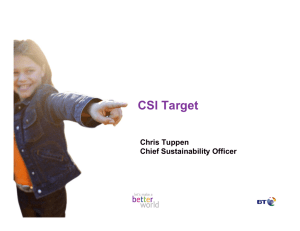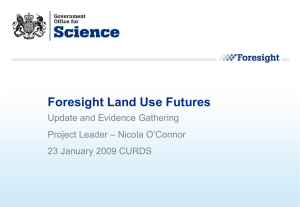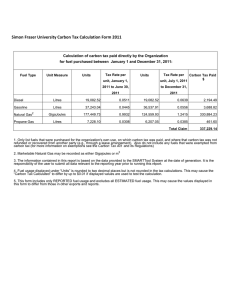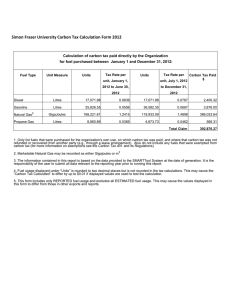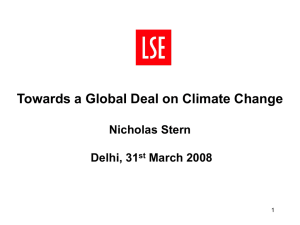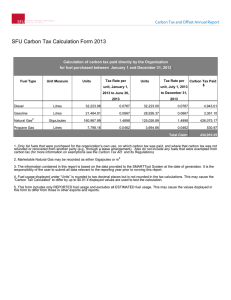Climate Stabilisation Intensity Targets
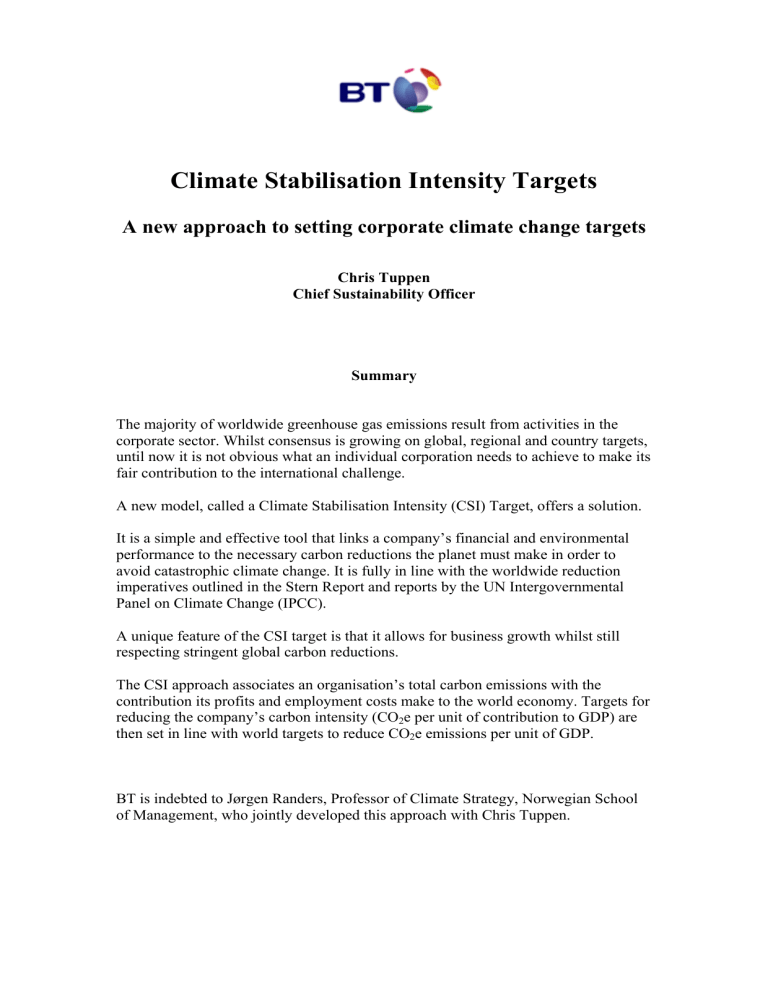
Climate Stabilisation Intensity Targets
A new approach to setting corporate climate change targets
Chris Tuppen
Chief Sustainability Officer
Summary
The majority of worldwide greenhouse gas emissions result from activities in the corporate sector. Whilst consensus is growing on global, regional and country targets, until now it is not obvious what an individual corporation needs to achieve to make its fair contribution to the international challenge.
A new model, called a Climate Stabilisation Intensity (CSI) Target, offers a solution.
It is a simple and effective tool that links a company’s financial and environmental performance to the necessary carbon reductions the planet must make in order to avoid catastrophic climate change. It is fully in line with the worldwide reduction imperatives outlined in the Stern Report and reports by the UN Intergovernmental
Panel on Climate Change (IPCC).
A unique feature of the CSI target is that it allows for business growth whilst still respecting stringent global carbon reductions.
The CSI approach associates an organisation’s total carbon emissions with the contribution its profits and employment costs make to the world economy. Targets for reducing the company’s carbon intensity (CO
2 e per unit of contribution to GDP) are then set in line with world targets to reduce CO
2 e emissions per unit of GDP.
BT is indebted to Jørgen Randers, Professor of Climate Strategy, Norwegian School of Management, who jointly developed this approach with Chris Tuppen.
50% reduction on 1990 levels by 2050
80
70
60
50
40
30
20
10
0
1990 2000 2010
BAU (+1.2%pa)
2020
-2.1% -2.8%
2030
-4.4%
Absolute CO
2 reduction target
2040
-6.1%
2050
Average world GDP growth at constant prices (1980 to 2007) = 3.6% pa
Decoupling of world CO2e emissions from economy (1990 to 2007) = 2.4% pa
Net business as usual growth of world CO2e emissions = 1.2 % pa
A global warming of 2°C is generally taken as the ‘tipping point’ beyond which there is a real risk of long-term irreversible climate change. More immediately, the 2008
UNDP report takes it as the ‘tipping point’ for large scale human development reversals during the 21st Century. The UNDP report therefore considers the 2°C temperature rise as a reasonable and prudent long term objective. This is consistent with the EU negotiating stance at the Bali negotiations for the Convention of the
Parties of the UN Framework Convention on Climate.
According to analysis from the Potsdam Institute for Climate Impact Research (PIK), stabilising atmospheric CO
2 e concentrations at 450ppm offers no more than a 50% probability of achieving the 2°C maximum temperature rise. The scale of the challenge ahead is highlighted by the fact that the current atmospheric concentration of CO
2 e is already in the region of 450ppm. (Note: Although current atmospheric concentrations of CO
2
are around 385ppm this is not the only global warming gas – others include methane and refrigeration gases. Taking account of these additional gases, and adjusting their atmospheric concentrations in line with their global warming potential relative to CO
2
, the current CO
2 e concentration is already in the region of 450ppm, where the ‘e’ in CO
2 e refers to ‘equivalent’.)
There are naturally many different pathways that could deliver an atmospheric CO
2 e stabilisation of 450ppm. However, the CSI model is based on a converging consensus that, from a 1990 base-year, CO
2 e emissions worldwide need to be reduced by around
50 percent by 2050, with emissions falling towards zero in net terms by the end of the
21st Century. The coloured lines simply show that the longer we wait before taking action the more difficult it will get to achieve a 50% reduction by 2050.
World CO
2
e intensity for 80% reduction in emissions
3.00
2.50
2.00
1.50
1.00
0.50
0.00
1990 2000 2010 2020
Reducing at 9.6%pa at current prices
2030 2040 2050
In line with the principles of contraction and convergence, developed countries are expected to aim for an emissions peak between 2012 and 2015, with 30% cuts by
2020 and at least 80% cuts by 2050. Developing countries meanwhile will essentially maintain a trajectory of rising emissions to 2020, peaking at around 80% above current levels, with cuts of 20% against 1990 levels by 2050.
Over the period 1980 to 2007 worldwide GDP growth has increased on average at
3.6% pa at constant prices (i.e. excluding inflation) and 5.9% pa at current prices (ie including inflation), whereas over the period 1990 to 2007 worldwide CO
2 e emissions have grown at 1.2% pa.
Calculating CO
2 e emissions relative to GDP creates a so called ‘intensity’ measure. A worldwide GDP of £29.0 trillion (USD 53.4 trillion) in 2007 gives an average global
CO
2 e intensity of 1.75 Kg / £ global GDP.
This graph shows global CO
2 e intensity per unit of worldwide GDP using historic data up to 2007 and then projecting to 2050 at 9.6%pa reduction. The 9.6% is based on the 80% reduction CO
2 e objective by 2050 and an assumed continued average
GDP growth rate of 5.9% pa at current prices.
Expressing GDP at constant prices is the more usual approach as it strips out inflation.
However, the CSI model is based on GDP growth expressed in terms of current prices as this allows a more direct connection with the financial data reported by companies.
The conclusion at this point is that in order to have a reasonable chance of stabilising the earth’s climate at no more than a 2°C temperature rise, and assuming an average
GDP growth cross all economies, requires developed world economies to reduce their
CO
2 e intensity at a compound rate of around 9.6% pa. But if this is what a country needs to do, what does a company need to do?
Footnote
Any variation of absolute emissions reductions and projected GDP growth rate can be modelled using the following equation where the annual rate of reduction of CO
2 e emission intensity (I%) from year Y to 2050 for an annual GDP growth rate of G%, and a C% per annum reduction in absolute carbon emissions between 1990 and 2050, is given by:
I% = 100(1 – (E
1990
(1-C%/100)/E
Y
)
1/(2050-Y)
/ (1+G%/100)) (1) where E
1990
represents the level of CO
2 e emissions in 1990 and E
Y
the level of CO
2 e emissions in year Y.
1998 Greenhouse Gas Protocol
Three Scopes
1. Direct emissions
2. Electricity
3. Optional eg business travel
The majority of worldwide CO
2 e emissions result from activities in the corporate sector. It is therefore not surprising that companies are being encouraged to measure, report and reduce their emissions.
The standard approach to corporate CO
2 e measurement is described by the Greenhouse Gas
Protocol developed jointly by the World Resources Institute (WRI) and the World Business
Council for Sustainable Development (WBCSD). This protocol requires companies to report both their direct emissions (e.g. from the operational burning of fossil fuels) and their indirect emissions caused as a result of the electricity they consume. In terms of the protocol these are termed Scope 1 and 2 emissions respectively. Emissions arising as a result of the use of a company’s products by their customers, or emissions from the supply chain, or from business travel, are covered in the optional Scope 3 category.
Whilst many companies separately and voluntarily report their CO
2 e emissions, the largest single depository of such data resides in the annual report of the Carbon Disclosure Project
(CDP). The sixth CDP report, published in September 2008 contained data from 77% (383) of the world’s 500 largest corporations, together accounting for 7.4 billion tonnes of CO
2
. In total 1550 companies responded globally.
Although companies are frequently encouraged to set CO
2 e reduction targets there is little guidance on what constitutes an appropriate target. Whilst consensus is growing on global, regional and country targets, it is not obvious what an individual corporation needs to achieve to make its fair contribution to the international objectives. When one considers that many multinational companies are of similar financial scale to some smaller countries it is clear that this is an important issue.
Many commentators have promoted the setting of long term absolute reduction targets for all companies. But such absolute targets are complicated by frequently encountered business matters such as organic and inorganic business growth, mergers, de-mergers and outsourcing.
A company should …..
3.00
2.50
2.00
1.50
1.00
0.50
0.00
1990
Reducing at 9.6%pa at current prices
2000 2010 2020 2030 2040 2050
Match or exceed this trend – ie its CO
2 e per unit of contribution to GDP* should drop by at least 9.6% pa
A company’s contribution to GDP is defined as its Value Added, where:
Value Added = EBITDA + employee costs = turnover – cost of bought in goods and services
The alternative to an absolute target is an intensity target as discussed at a macroeconomic level above. However, intensity, and other normalised targets, are often criticised as they can appear to show improvements whilst masking absolute increases in CO
2 e emissions.
A climate stabilising intensity target, or CSI target, is a new type of intensity target that links a company’s financial and environmental performance to the necessary intensity reductions needed to avoid irreversible climate change. To calculate this measure we not only need a company’s CO
2 e emissions, but also its contribution to the world economy.
In economic terms a company’s contribution to GDP is termed its Value Added.
Whilst Value Added is not a commonly understood metric, at least compared to more frequently used metrics such as turnover, its concept is in common usage through
Value Added Tax (VAT).
A company’s Value Added is defined as:
Value Added = EBITDA + employee costs
The same parameter can also be expressed as:
(2)
Value Added = turnover – cost of bought in goods and services (3)
This leads us to the CSI measure of:
Intensity e emissions / Value Added (4)
Having calculated its CO
2 e intensity in terms of CO
2 e emissions per unit of Value
Added, a target can now be set. For a company operating primarily in developed economies an 80% reduction in global CO
2 e between 1990 and 2050 should be selected against a world GDP growth rate at current prices of 5.9% pa. This gives a target of 9.6% reduction in intensity per annum. Thus any developed economy company reducing its intensity, measured in terms of CO
2 e emissions per unit of
Value Added, by 9.6% pa could be considered to be contributing its fair share towards stabilising the climate. This is why we call it a Climate Stabilising Intensity Target.
Adding in BT’s CO
2
e intensity
(
Intensity =
Value Added
)
3
2.5
2
1.5
1
0.5
0
1990
Reducing at 9.6%pa
2010
BT
2000
BT base line year 1996/7
2020 2030 2040 2050
By way of example consider we now consider application of the CSI target to BT.
BT is one of the world’s leading providers of communications solutions and services operating in 170 countries. Its principal activities include networked IT services, local, national and international telecommunications services, CO
2
and higher-value broadband and internet products and services. It set its first reduction target in 1992 and since then has embarked on a programme of energy efficiency, procurement of low carbon electricity and on site renewable generation. In January 2007 BT announced a tighter absolute CO
2 e reduction target for its UK operations of an 80% reduction by 2016 against its 1996 base year (technically the 96/97 financial year).
Whilst the majority of its revenue is still derived in the UK where it consumes 0.7% of all UK electricity, BT operations outside the UK have been growing at a rapid rate, often through acquisition of young companies, many of which had not even existed in
1996. This made it impossible to set a similar absolute target outside the UK. In addition, the BT executive Board requested the development of a single target that would accommodate all group operations worldwide. A CSI target offered the solution.
This graph shows how BT’s CO
2 e per unit of value added has decreased since the
1996. It also shows the global curve from the previous slide.
One take away from this slide is that BT creates around ten times the amount of wealth per unit of CO
2 e emissions than the ‘average’ company in the economy. This is not surprising as the ICT industry does not have a high carbon intensity compared to many other sectors such as steel or airlines.
Setting a Climate Stabilisation Intensity Target
80% reduction target by 2020
In this graph the global curve has been scaled to coincide with BT in its 1996 baseline year.
Beyond 2008 BT’s projected data is based on an increase in its Value Added in line with statements made to its investors of EBITDA growth of 2.5% pa. Between 2008 and 2016 its UK emissions are expected to fall in line with the absolute target described above, with non-UK emissions growing at 4% pa. Between 2016 and 2025 all BT emissions are expected to fall at 4% pa and between 2025 and 2050 at 7.8% pa.
In combination, this has allowed BT to set itself a CSI target to reduce its CO
2 e intensity by 80% by 2020 against its 1996 baseline.
BT’s emissions are dropping in real terms
1,800
1,600
1,400
1,200
1,000
800
600
400
200
-
BT intends meeting its CSI target through a continued combination of energy efficiency, on-site renewable generation (aiming for 25% of it UK electricity to come from dedicated wind turbines by 2016) and purchased low-carbon electricity. This graph shows how the company’s absolute emissions are projected to fall continuously between 2007 and 2050.
Advantages of a CSI target
• Combines company environmental and financial performance
• Links company performance to global environmental and economic performance
• Accommodates the normal dynamics of businesses such as organic growth, acquisitions and outsourcing
• Provides a framework for modelling future strategy
• Allows straightforward benchmarking
Whilst long term absolute reduction targets for companies are heavily promoted, they are often complicated by their inflexibility with respect to the normal dynamics of the corporate world.
As an alternative to an absolute target many companies have adopted targets based on more flexible intensity measures. These measures are usually expressed in terms of
CO
2 e divided by a business related metric such as revenue, number of employees, or units of production etc. At worst such intensity targets can mask unacceptable increases of emissions in real terms, at best it is difficult to relate them to the internationally accepted reductions required to stabilise the climate. As such it makes it difficult to benchmark companies using many intensity targets, let alone know if a company is taking its ‘fair share’ of the climate challenge.
The CSI target, whilst still far from perfect, helps to resolve some of these problems.
As it is related to GDP it directly links the micro-economics of an individual company to global macro-economics. This allows one to establish if a company is delivering its fair share of effort, as well as providing a benchmark against which different companies can be evaluated. It also provides for often encountered business dynamics such as organic and inorganic growth, and outsourcing.
For a company growing organically, its value added will increase. If its value added is growing very rapidly (ie >9.6% pa) then, within the context of a CSI, it could even justifiably increase its CO
2 e emissions. For most companies this is an unattainable rate of business growth. Even so, different businesses will be growing, or even contracting at different rates. But this is acceptable with the CSI context as the average rate of business growth will be reflected in national GDP figures. This results in organic business growth and contraction automatically being accommodated within the CSI target approach.
Where a company grows inorganically – that is through acquisition - it will both acquire CO
2 e emissions and value added. These are added to the numerator and denominator of the intensity measure respectively, again making it self consistent with the CSI target metric. Disposals simply work this logic in reverse.
Where a company outsources an activity to a supplier then the related CO
2 e emissions will be removed from its books. In the case of the CSI metric this is accommodated by a corresponding increase in the cost of bought in goods and services. As its turnover is likely to remain constant, its value added will drop according to equation
3, which will, to some extent, compensate for the drop in CO
2 e . Similarly where a company acts as a supplier and insources an activity from one of its customers this logic works in reverse.
The CSI approach is still not a perfect answer. For example, a company could deliberately choose to outsource or dispose of its more carbon intensive activities.
Whilst this will make it easier to meet a CSI target, the fact that this also changes its value added means there is at least a level of automatic adjustment that doesn’t take place with a standard absolute reduction target.
One of the disadvantages of the CSI framework is that it is initially more complex than a straight forward absolute reduction approach, at least in terms of ease of communication. Most people are not used to the concept of value added – even though it is common language through VAT. However, the concept of GDP is generally understood by most people even though they probably don’t properly understand how it is derived.
Climate
Stabilisation
Intensity
Target
Ensures emission reductions are sufficient to prevent catastrophic climate change.
Links climate protection to economic growth.
Green growth for a low carbon future
Summary slide
The CSI approach provides a flexible methodology that provides for business and economic growth whilst, and at the same time, respects the absolute reductions in emissions that need to occur in order to stabilise the earth's climate.
For more information please contact:
Chris Tuppen
BT Chief Sustainability Officer
Tel: +44 (0)20 7356 5729 Fax: +44 (0)20 7356 5675 Mobile: +44 (0)7710 039337 e-mail: chris.tuppen@bt.com
